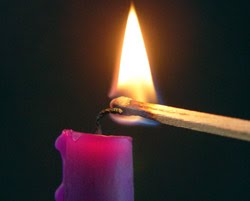
Advent: November 2010 Archives



The new liturgical year begins tonight at First Vespers for Advent (as a point of comparison, the Church in Milan which follows its own liturgical calendar and set of customs began Advent on November 14th). A new liturgical year refreshes our understanding of good Catholic customs and practices, a renews the emphasis of ongoing conversion and encourages a lively following of God Incarnate -- all these things are essential hallmarks of Advent.
The newness the Advent gives to us is seen as a feast for the senses (Catholics are sensual people) known through investment of our best resources and energies: the Church's vesture changes to purple, silence is observed a little more in the Liturgy, the sacred Scriptures draws out attention to waiting and preparing the way of the Lord (think of the Prophet Isaiah pictured right), the season's music focuses our hopes and loves on the Kingdom already present but not fully realized and our homes, the "domestic church," reinforces our seeking God together. As Father U. Michael Lang, CO, said in a recent essay on vestments, "Divine beauty manifests itself in an altogether particular way in the sacred liturgy, also through material things of which man, made of soul and body, has need to come to spiritual realities: the buildings of worship, the furnishings, the vestments, the images, the music, the dignity of ceremonies themselves."
As one small sign for the daily and weekly movement of this season of preparation is the Advent wreath, a tangible sign of movement to recognizing more deeply that our Salvation is at hand. The Advent wreath is, however, not a parish church custom as much as it is custom for one's home (but you can't persuade too many priests to move the Advent wreath out of the sanctuary these days).
A favorite historian of liturgical customs is Jesuit Father Francis X. Weiser's 1958 Handbook of Christian Feasts and Customs: The Year of the Lord in Liturgy and Folklore, but I also look to Pius Parsch, Dom Gueranger and the Directory of Popular Piety and the Liturgy (2001) to recall the Advent sensibility given to us by the Church. These authors are particularly helpful in preparing the faithful and especially the children in the Catechesis of the Good Shepherd and other CCD programs about the sacred Liturgy. About the Advent wreath Weiser writes:
The Advent wreath originated a few hundred years ago among the Lutherans of eastern Germany. It probably was suggested by one of the many light symbols which were used in folklore at the end of November and beginning of December... The Christians in medieval times kept many of these lights and fire symbols alive as popular traditions and ancient folklore. In the sixteenth century the custom started of using such lights as a religious symbol of Advent in the houses of the faithful. This practice quickly spread among the Protestants of eastern Germany and was soon accepted by Protestants and Catholics in other parts of the country. Recently it has not only found its way to America, but has been spreading so rapidly that it is already a cherished custom in many homes.
The Advent wreath is exactly what the word implies, a wreath of evergreens (yew or fir or laurel), made in various sizes. It is either suspended from the ceiling or placed on a table, usually in front of the family shrine. Fastened to the wreath are four candles standing upright, at equal distances. These candles represent the four weeks of Advent.
Daily at a certain time (usually in the evening), the family gathers for a short religious exercise. Every Sunday of Advent one more candle is lit, until all four candles shed their cheerful light to announce the approaching birthday of the Lord. All other lights are extinguished in the room, and only the gentle glow of the live candles illuminates the darkness. After some prayers, which are recited for the grace of a good and holy preparation for Christmas, the family sings one of the traditional Advent hymns or a song in honor of Mary.
The traditional symbolism of the Advent wreath reminds the faithful of the Old Testament, when humanity was "sitting in the darkness and in the shadow of death" (Luke 2:79); when the prophets, illumined by God, announced the Redeemer; and when the hearts of men glowed with the desire for the Messiah. The wreath -- an ancient symbol of victory and glory -- symbolizes the "fulfillment of time" in the coming of Christ and the glory of His birth.
In some sections of Europe it is customary for persons with the name of John or Joan to have the first right to light the candles on the Advent wreath and Christmas tree, because John the Evangelist starts his Gospel by calling Christ the "Light of the World" and John the Baptist was the first one to see the light of divinity shining about the Lord at His baptism in the Jordan. (pp. 54-55)

 Marking the beginning of Advent for the Roman Church,
the Holy Father invited the world's dioceses (parishes & religious
institutions) religious communities, ecclesial movements and associations
throughout the world to join him in a Solemn Vigil for All Nascent Human Life (resources here).
Marking the beginning of Advent for the Roman Church,
the Holy Father invited the world's dioceses (parishes & religious
institutions) religious communities, ecclesial movements and associations
throughout the world to join him in a Solemn Vigil for All Nascent Human Life (resources here).


